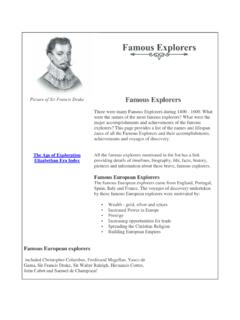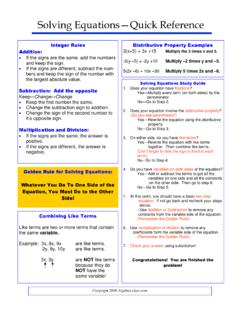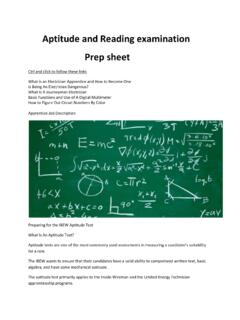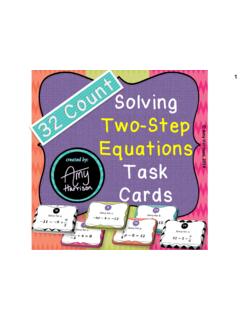Transcription of !! Algebra 1 Unit Plan
1 Algebra 1 Unit Plan Unit 1: Quantitative Relationships, Graphs, and Functions September 9th October 3rd ORANGE PUBLIC SCHOOLS 2014 - 2015. OFFICE OF CURRICULUM AND INSTRUCTION. OFFICE OF MATHEMATICS. Algebra 1 Unit 1 September 9th October 3rd Contents Unit Overview .. 2 Calendar .. 4 Assessment Framework .. 5 Scope and Sequence .. 6 Ideal Math Block .. 37 Sample Lesson Plan .. 38 Supplemental Material .. 40 Multiple Representations .. 41 Unit Authentic Assessment .. 43 PARCC Sample Assessment Items .. 44 Unit Assessment Question Bank .. 46 Additional Resources .. 47 Appendix A Acronyms .. 48 1. Algebra 1 Unit 1 September 9th October 3rd Unit Overview Unit 1: Quantitative Relationships, Graphs, and Functions Essential Questions In what ways can we manipulate an algebraic equation to find the value of an unknown quantity? How do variables help you model real- world situations and solve equations? How can you determine if something is a mathematical function? How can we use mathematical models to describe physical relationships?
2 How can we use different tools and representations to solve problems? How can the same linear relationship be represented in multiple ways? Enduring Understandings By applying mathematical properties, a linear equation can be manipulated to produce many different but equivalent forms. These manipulations can lead to solution for the unknown value. Units can be used to describe and explain steps and solutions of problems that model a real world scenario. Functions can be categorized into function families, each with their own algebraic and graphical characteristics. There are often two quantities that change in problem situations. One of these quantities depends on the other, making it the dependent quantity and the other the independent quantity A mathematical function is a relation between a set of inputs (values of the domain) and outputs (values of the range) in which one element of the domain is assigned to exactly one element of the range. A linear relationship is one where the dependent quantity is changing at a constant rate per unit of the independent quantity.
3 A Linear function can be represented in multiple ways and can be used to model and solve problems in a real world context. Common Core State Standards 1) : Explain each step in solving a simple equation as following from the equality of numbers asserted at the previous step, starting from the assumption that the original equation has a solution. Construct a viable argument to justify a solution method. 2) : Solve linear equations and inequalities in one variable, including equations with coefficients represented by letters. 3) : Understand that a function from one set (called the domain) to another set (called the range) assigns to each element of the domain exactly one element of the range. If f is a function and x is an element of its domain, then f(x) denotes the output of f corresponding to the input x. The graph of f is the graph of the equation y = f(x). 4) : Use units as a way to understand problems and to guide the solution of multi- step problems; choose and interpret units consistently in formulas; choose and interpret the scale and the origin in graphs and data displays.
4 5) : Define appropriate quantities for the purpose of descriptive modeling. 6) : Choose a level of accuracy appropriate to limitations on measurement when reporting quantities. 7) : Understand that the graph of an equation in two variables is the set of all its solutions plotted in the coordinate plane, often forming a curve (which could be a line). 8) : Create equations and inequalities in one variable and use them to solve problems. Include equations arising from linear and quadratic functions, and simple rational and exponential functions. 9) : Create equations in two or more variables to represent relationships between quantities; graph equations on coordinate axes with labels and scales. 10) : Use function notation, evaluate functions for inputs in their domains, and interpret 2. Algebra 1 Unit 1 September 9th October 3rd statements that use function notation in terms of a context. 11) : Relate the domain of a function to its graph and, where applicable, to the quantitative relationship it describes.
5 For example, if the function h(n) gives the number of person- hours it takes to assemble n engines in a factory, then the positive integers would be an appropriate domain for the function.* 12) : Graph functions expressed symbolically and show key features of the graph, by hand in simple cases and using technology for more complicated cases.* Graph linear and quadratic functions and show intercepts, maxima, and minima. 13) : Recognize situations in which one quantity changes at a constant rate per unit interval relative to another. 14) : Interpret expressions that represent a quantity in terms of its context. M : Major Content S: Supporting Content A : Additional Content 3. Algebra 1 Unit 1 September 9th October 3rd Calendar September 2014 Sun Mon Tue Wed Thu Fri Sat 1 2 3 4 5 6 7 8 9 10 11 12 13 First day of Using models Distributive Variables and school for integer property expressions Using models operations for integer Diagnostic operations assessment 14 15 16 17 18 19 20 Input output Mathematical Independent vs.
6 Domain/range Function tables / Intro to functions dependent and discrete/ notation and functions quantities continuous recognizing graphs function families Checkup #1 21 22 23 24 25 26 27 Solving linear Modeling a day for Analyzing linear Analyzing linear equations linear situation students functions functions Modeling a linear situation 28 29 30 1 2 3 Solving linear Performance Review Unit 1 Exam Flex day inequalities task Checkup #2 4. Algebra 1 Unit 1 September 9th October 3rd Assessment Framework Assessment CCSS Estimated Time Date Format Graded Diagnostic/Readiness , , Block 9/10/14 or Individual No Assessment , , , after CL Chapter 1 Pretest #'s 1- 6 , , , Lesson 2 CL Chapter 2 Pretest #'s 1- 5 , Assessment Checkup #1 , , , Block 9/19/14 or Individual Yes CL Chapter 1 End of Chapter , , after Test #'s 1, 2, 5, 8, 10 Lesson 9 Assessment Checkup #2 , , Block 9/29/14 or Individual Yes CL Chapter 2 End of Chapter , , , after Test , Lesson 13 #'s 1- 6 Performance Task , , 1 Block 9/30/14 Pair or Group Yes Ivy Smith Grows Up , , Unit 1 Assessment , , 1 Block 10/2/14 Individual Yes , , , , , , , , , , , Assessment check points (exit Varies by lesson 5- 10 minutes Everyday Individual Varies tickets) 5.
7 Algebra 1 Unit 1 September 9th October 3rd Scope and Sequence Overview Lesson Topic Suggesting Pacing and Dates 1 Using models for integer operations (addition/subtraction) 1 day: 9/9/2014 2 Using models for integer operations (multiplication/division) 1 day: 9/10/2014 3 Variables and expressions 1 day: 9/11/2014 4 Distributive property 1 day: 9/12/2014 5 Input output tables / Intro to functions 1 day: 9/15/2014 6 Mathematical functions 1 day: 9/16/2014 7 Independent vs. dependent quantities 1 day: 9/17/2014 8 Domain/range and discrete/continuous graphs 1 day: 9/18/2014 9 Function notation and recognizing function families 1 day: 9/19/2014 10 Solving linear equations (justifying with mathematical reason) 1 day: 9/22/2014 11 Modeling a linear situation 2 days: 9/23/2014 9/24/2014 12 Analyzing linear functions 2 days: 9/25/2014 9/26/2014 13 Solving linear inequalities 1 day: 9/29/2014 14 Performance task 1 day: 9/30/2014 15 Review 1 day: 10/1/2014 Summary: 15 days on new content (13 lessons/topics) 1 task day 1 review day 1 test day 1 flex day 19 days in Unit 1 Lessons 1 2 3 4 5 6 7 8 9 10 11a 11b 12a 12b 13 x x x x x x x x x x x x x x x x x x x x CCSS x x x x x x x x x x x x x x x x x x x x 6.
8 Algebra 1 Unit 1 September 9th October 3rd Lesson 1: Using models for integer operation (addition/subtraction) Objectives Through the use of several mathematical models, students will be able to add and subtract integers fluently by correctly answering ___ out of ____ on a timed drill activity. Focused Mathematical Practices MP 2: Reason abstractly and quantitatively MP 5: Use appropriate tools strategically (use the models provided) MP 6: Attend to precision (use correct vocabulary and require students to do the same) Vocabulary Opposite, zero pairs, absolute value, natural/counting numbers, whole numbers, integers, real numbers, subtraction, additive inverses Common Misconceptions Students may struggle with the new definition of subtraction. Use numerical examples ( 4 1 = 4 + - 1) that they are familiar with to explain this new way of thinking about subtraction problems. Put parentheses around the second number ( 4 (1) = 4 + (- 1)) or use the trick keep- change- change for students who need additional support.
9 Lesson Clarifications If time is an issue, only focus on the Opener and Consolidation Activity Concepts Skills Material/ Suggested Assessment CCSS What students will know What students will be able to do Resource Pacing Check Point : Apply and Review Review AM 1 day AR extend previous Adding a positive value Adding and subtracting understandings of makes a value bigger, integers addition and adding a negative value New subtraction to add and makes a value smaller Rewriting a subtraction subtract rational The sum of a pair of expression as an numbers; represent opposite numbers is equivalent addition addition and zero. We can call these expression subtraction on a zero pairs. horizontal or vertical New number line diagram. Subtracting a number is the same as adding its opposite Number lines and Algebra can be used to model the addition of integers 7. Algebra 1 Unit 1 September 9th October 3rd Lesson 2: Using models for integer operation (multiplication/division) Objectives By examining patterns in tables, students will be able to construct rules for multiplying signed numbers and multiply/divide integers fluently by correctly completing ___ out of ____ parts on a cheat sheet.
10 Focused Mathematical Practices MP 2: Reason abstractly and quantitatively MP 5: Use appropriate tools strategically (use the model provided) MP 8: Look for and express regularity in repeated reasoning Vocabulary Product Common Misconceptions Students may be able to complete tables and observe patterns, yet still struggle with constructing rules for products of signed numbers. Consider providing additional supports such as asking them to create their own table with new numbers, giving them sets of 4 multiplication problems (one of each kind) where they have to use the tables to find the answer, or pairing them with varied levels. Lesson Clarifications Only focus on the Opener and Consolidation Activity May need to supplement with additional examples/tables Concepts Skills Material/ Suggested Assessment CCSS What students will know What students will be able to do Resource Pacing Check Point : Apply and Review Review AM 1 day AR extend previous Knowing the resulting Multiplying integers understandings of sign of any product New multiplication and New division and of fractions Using patterns in tables to multiply and divide to explain the product rational numbers.















